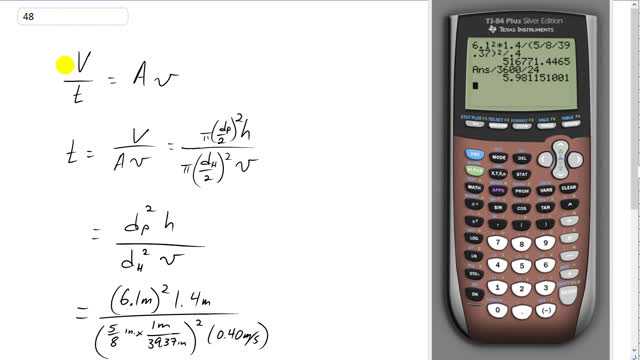
A -in. (inside) diameter garden hose is used to fill a round swimming pool 6.1 m in diameter. How long will it take to fill the pool to a depth of 1.4 m if water flows from the hose at a speed of ?

In order to watch this solution you need to have a subscription.
This is Giancoli Answers with Mr. Dychko. The volume rate of flow of water through this hose, volume divided by time in other words, equals the area of the hose times the speed of water going through it. So we can solve for t by multiplying both sides by t and dividing by Av and on the left side, we'll end up with t's canceling and having V over Av and on the right side, we'll just have t and then we'll switch the sides around. So we have t equals volume divided by area times v. So this volume is the volume of the pool— that's the volume of water that has to come out of the hose. So that's π times r squared times h that's the volume of a cylinder the area of one end of the cylinder multiplied by its height. So this is diameter over 2—d P for pool over 2—all squared and then on the bottom we have area of the hose so π times diameter of the hose over 2 squared times the speed of water through it. The π's cancel, the 1 over 4 cancels on top and bottom, and you are left with diameter of the pool squared times its height divided by the diameter of the hose squared times the water's speed. And we have 6.1 meters—diameter of the pool—squared times 1.4 meters—height— divided by 5/8th inches times 1 meter for every 39.37 inches, you need that conversion factor in there, and square that result then also divide by 0.40 meters per second. And this gives us 516771 seconds and we'll multiply that by 1 hour for every 3600 seconds and then times by 1 day for every 24 hours to turn this into something that we can relate to better and the answer is 6.0 days for this hose to fill a pool.
when i put this in my calculator im not getting the same answer